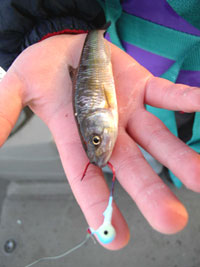Double Dipping
 Devote Seinfeld fans know all about “double dipping”, an inexcusable offense where an individual places a chip into any type of dip, takes a bite, then returns the chip to the dip to retrieve more of the sought after compound. In my family, a reminder of, “No, double dipping!” is always uttered before the relish tray and veggie dip is even set on the table.
Devote Seinfeld fans know all about “double dipping”, an inexcusable offense where an individual places a chip into any type of dip, takes a bite, then returns the chip to the dip to retrieve more of the sought after compound. In my family, a reminder of, “No, double dipping!” is always uttered before the relish tray and veggie dip is even set on the table.
Humans are sometimes particular about the practice of double dipping, but fish are much less discerning. They don’t mind if bait has been previously chewed or if a portion is missing. Or do they? And if so, when does it make a difference?
For smaller, highly competitive fish that populate lakes in high numbers, especially around the resort dock as bluegill often do, a small chunk of worm or portion of a leech will often catch fish after fish until the bait finally comes off. But other species of fish are definitely more aware of livebait’s liveliness, although you can often fool a fish through presentation.
For instance, when fishing for crappie anytime of the year, a slip bobber with a crappie minnow hooked delicately through the back, allowing a parallel position to the bottom will entice fish from afar to take notice of the writhing target. But after one fish, and sometimes only one bite, the minnow must be exchanged for a fresh swimmer. In this situation the minnow itself provides the majority of the presentation’s action. An alternative and great way to extend your dollar is to alter the presentation by switching to a jig without the accompanying float. Your presentation will change from vertical (directly beneath the float), to horizontal. You will now be able to more effectively cover more water in a highly efficient manner using a slow retrieve and for once it will become socially acceptable to “double dip”. You will no longer need to replace your minnow at the first sign of physical distress because now you, the angler, are in total control of the movements displayed by the bait. Every time you drop the rod tip, the bait falls. Jig while slowly retrieving the bait and it will undulate, giving the appearance of a live, thrashing minnow.
The same minor change in presentation can also be applied to nightcrawlers and leeches. Walleye are particularly fond of all three of the mentioned livebait categories, but are highly critical of their healthiness. A listless minnow, waterlogged crawler or ragged leech simply won’t get as much attention as a moving target.
Nightcrawlers perform quite well presented on a jig, but anglers often pass up the idea because of tenacious bluegill or perch that seem to revel in stealing a worm, despite the presentation you choose. However, the jig and nightcrawler works best in those situations, as compared to a slip bobber or a Lindy rig. The reason? You have full control of how to make that worm dance and jiggle on the end of the hook. Think of what a lively nightcrawler looks like on the end of a Lindy rig. Simply stated, it writhes. If you wanted to give that action artificially to a soggy nightcrawler on a Lindy rig, you might try to twitch the rod tip to the side, which will primarily make the worm move and stop, or you can lift the rod tip and drop it again, which provides more action for the walking sinker than for the worm. Neither of those techniques make the worm writhe similarly to that of an active nightcrawler.
Now think of the action that an angler armed with a jig can give to a half or whole nightcrawler. A Lindy Maxx Gap jig, with its Techniglo finish and red hook is superior since the weight of the presentation is located in combination with the livebait instead of a few feet away, each twitch of the rod tip makes the jig move, but ironically the nightcrawler moves slower than the jig. It’s a copycat motion, where the jig jumps and the worm follows with slight hesitation. Panfish, the worm bruising thugs of fishing, are no longer a threat because a beat up worm that would typically be traded for a fresh upgrade can now be fished until the worm is actually gone, nipped away to nothing.
With a leech it’s the same premise. Hook the bait on a jig and prepare to be amazed at how long you can fish the bait, alive or not, and continue to effectively catch fish. And when your friends ask how you caught the beautiful mess of fish, the answer is simple. “Double dipping.”





